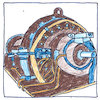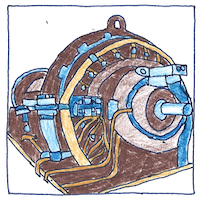Ernst Alexanderson
electromagnetism

|
Alexanderson alternator
Before 1904, many inventors, including Nikola Tesla, created an alternator to generate an electromagnetic frequency, but none of these produced a frequency high enough for radio transmission; they were all under twenty kilohertz. However, in 1904, Reginald Fessenden, working for National Electric Signaling Company, contracted with GE for an alternator to produce up to a hundred kilohertz for continuous wave radio transmission. Ernst Alexanderson designed an alternator whose frequency was controlled by a rotor with hundreds of narrow slots that caused a variable reluctance to interrupt the flux, which induced a radio-frequency voltage in a set of coils.
Transoceanic broadcasts
The Alexanderson alternator allowed the installation of broadcast stations around the world for broadcasting transoceanic high-power longwave radiotelegraphic messages in Morse code, which became an urgent requirement during World War I.
Alexanderson Day
The Varberg Radio Station near Grimeton, Sweden, celebrates Alexanderson Day by broadcasting Morse code messages on 17.2 kHz using the last working Alexanderson alternator.
The box
People thought you needed a spark-gap transmitter to make radio waves. Today we call that thinking inside the box.



In 1903, Charles Proteus Steinmetz of GE delivered a ten-kilohertz alternator-transmitter, which Fessenden could not use as a radio transmitter. Ernst Alexanderson’s effort was far more successful; however, alternator-transmitters were eventually replaced by vacuum-tube transmitters.
See also in The book of science:
Readings in wikipedia:
Other readings: